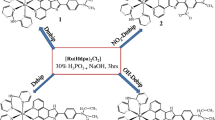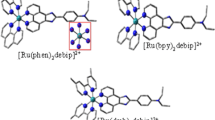Abstract
The novel ligand (dmbip) 2-(4-N, N-dimethylbenzenamine)1H-imidazo[4, 5-f][1, 10]phenanthroline and its complexes [Ru(phen)2dmbip]2+ (1), [Ru(bpy)2dmbip]2+ (2), [Co(phen)2dmbip]3+ (3) and [Co(bpy)2dmbip]3+ (4) [where phen = 1, 10-phenanthroline, bpy = 2, 2′-bipyridine], have been synthesized and characterized by elemental analysis, IR, UV-Vis, 1H NMR, 13C NMR and Mass spectra. The DNA binding properties of the complexes were investigated by absorption, emission, quenching studies, light switch “on and off”, salt dependent, sensor (cation and anion) studies, viscosity measurements, cyclic voltammetry, molecular modeling and docking studies. The four complexes were screened for Photo cleavage of pBR322 DNA, antimicrobial activity and cytotoxicity. The experimental results indicate that the four complexes can intercalate into DNA base pairs. The DNA-binding affinities of these complexes follow the order [Ru(phen)2dmbip]2+ > [Co(phen)2dmbip]3+ > [Ru(bpy)2dmbip]2+ > [Co(bpy)2dmbip]3+.












Similar content being viewed by others
References
Brunschwig BS, Creutz C, Sutin N (1998) Electroabsorption spectroscopy of charge transfer states of transition metal complexes. Coord Chem Rev 177:61–79
Kober EM, Meyer TJ (1982) Concerning the absorption spectra of the ions M(bpy)t + (M = Fe, Ru, Os; bpy = 2,2′-bipyridine). Inorg Chem 21:3967–3977
Kober EM, Marshall JC, Dressick WJ, Sullivan BP, Caspar JV, Meyer TJ (1985) Synthetic control of excited states. Nonchromophoric ligand variations in polypyridyl complexes of osmium(II). Inorg Chem 24:2755–2763
Barton JK (1986) Metals and DNA: molecular left-handed complements. Science 233:727–734
Norden B, Lincoln P, Akerman B, Tuite E (1996) DNA interaction with substitution-inert transition metal ion complexes. Met Ions Biol Syst 33:177
Ji LN, Zou XH, Liu JG (2001) Shape- and enantioselective interaction of Ru(II)/Co(III) polypyridyl complexes with DNA. Coord Chem Rev 216:513–536
Chen HL, Yang P, Yuan CX, Pu XH (2005) Study on the binding of base-mismatched oligonucleotide d(GCGAGC)2 by cobalt(III) complexes. Eur J Inorg Chem 2005:3141–3148
Kane-Maguire NAP, Weeler JF (2001) Photoredox behavior and chiral discrimination of DNA bound M(diimine)3 n+ complexes (M = Ru2+, Cr3+). Coord Chem Rev 211:145–162
Kaes C, Katz A, Hosseini MW (2000) Bipyridine: the most widely used ligand. A review of molecules comprising at least two 2,2′-bipyridine units. Chem Rev 100:3553–3590
Armitage B (1998) Photocleavage of nucleic acids. Chem Rev 98:1171–1200
Sigman DS, Mazumdre A, Perrin DM (1993) Chemical nucleases. Chem Rev 93:2295–2316
De Armond MK, Carlin CM (1981) Multiple state emission and related phenomena in transition metal complexes. Coord Chem Rev 36:325–355
Xu H, Zheng KC, Deng H, Lin LJ, Zhang QL, Ji LN (2003) Effects of the ancillary ligands of polypyridyl ruthenium(II) complexes on the DNA-binding behaviors. New J Chem 27:1255–1263
Liu J-G, Zhang Q-L, Shi X-F, Ji L-N (2001) Interaction of [Ru(dmp)2(dppz)]2+ and [Ru(dmb)2(dppz)]2+ with DNA: effects of the ancillary ligands on the DNA-binding behaviors. Inorg Chem 40:5045–5050
Yata PK, Shilpa M, Nagababu P, Reddy MR, Kotha LR, Gabra NM, Satyanarayana S (2012) Study of DNA light switch Ru(II) complexes: synthesis, characterization, photocleavage and antimicrobial activity. J Fluoresc 22:835–847
Vidhisha S, Kotha LR, Ashwini Kumar K, Yata PK, Satyanarayana S (2010) DNA interactions of ruthenium (II) complexes with a polypyridyl ligand: 2-(2, 5dimethoxyphenyl)-1H-imidazo[4, 5-f] 1, 10-phenanthroline. Transit Met Chem 35:1027–1034
Shilpa M, Naveena Lavanya Latha J, Gayatri Devi A, Nagarjuna A, Kumar YP, Nagababu P, Satyanarayana S (2011) DNA-interactions of ruthenium(II) & cobalt(III) phenanthroline and bipyridine complexes with a planar aromatic ligand 2-(2-fluronyl)1H-imidazo[4,5-f][1,10-Phenanthroline]. J Incl Phenom Macrocycl Chem 70:187–195
Shobha Devi C, Anil Kumar D, Singh SS, Gabra NM, Deepika N, Yata PK, Satyanarayana S (2013) Synthesis, interaction with DNA, cytotoxicity, cell cycle arrest and apoptotic inducing properties of ruthenium(II) molecular “light switch” complexes. Eur J Med Chem 64:410–421
Deepika N, Yata PK, Shobha Devi C, Venkat Reddy P, Srishailam A, Satyanarayana S (2013) Synthesis, characterization, and DNA binding, photocleavage, cytotoxicity, cellular uptake, apoptosis and on–off light switching studies of Ru (II) mixed-ligand complexes containing 7-fluorodipyrido [3, 2-a: 2′, 3′-c] phenazine. J Biol Inorg Chem 18:751–766
Srishailam A, Yata PK, Gabra NM, Venkat Reddy P, Deepika N, Veerababu N, Satyanarayana S (2013) Synthesis, DNA-binding, cytotoxicity, photo cleavage, antimicrobial and docking studies of Ru(II) polypyridyl complexes. J Fluoresc 23:897–908
Gabra NM, Mustafa B, Yata PK, Shobha Devi C, Srishailam A, Venkat Reddy P, Kotha LR, Satyanarayana S (2013) Synthesis, characterization, DNA binding studies, photocleavage, cytotoxicity and docking studies of ruthenium(II) light switch complexes. J Fluoresc. doi:10.1007/s10895-013-1283-x (Accepted)
Ashwini KK, Kotha LR, Vidhisha S, Satyanarayana S (2009) Synthesis, characterization and DNA binding and photocleavage studies of [Ru(bpy)2BDPPZ]2+, [Ru(dmb)2BDPPZ]2+ and [Ru(phen)2BDPPZ]2+ complexes and their antimicrobial activity. Appl Organomet Chem 23:409–420
Kotha LR, Reddy YH, Kumar KA, Vidhisha S, Satyanarayana S (2009) Synthesis, characterization, DNA-binding, and DNA-photocleavage properties of [Co(bpy)2(7-NO2-dppz)]3+, [Co(dmb)2(7-NO2-dppz)]3+, and [Co(phen)2(7-NO2-dppz)]3+ complexes: (7-nitro-dppz = 7-nitro dipyrido[3,2-a:2′-3′-c]phenazine; bpy = 2,2′-bipyridine; dmb = 4,4′-dimethyl-2,2′-bipyridine; phen = 1,10-phenanthroline) and their toxicity on different microorganisms. Nucleosides Nucleotides Nucleic Acids 28:204–219
Nagababu P, Satyanarayana S (2007) DNA binding and cleavage properties of certain ethylenediamine cobalt(III) complexes of modified 1,10–phenanthrolines. Polyhedron 26:1686–1692
Nagababu P, Kumar DA, Reddy KL, Kumar KA, Mustafa MB, Shilpa M, Satyanarayana S (2008) DNA binding and photocleavage studies of cobalt(III) ethylenediamine pyridine complexes: [Co(en)2(py)2]3+ and [Co(en)2(mepy)2]3+. Metal Based Drugs 2008:275084
Pallavi P, Nagababu P, Satyanarayana S (2007) Biomimetic model of coenzyme B12: aquabis(ethane-1,2-diamine-κN, κN′)ethylcobalt(III)—its kinetic and binding studies with imidazoles and amino acids and interactions with CT DNA. Helv Chim Acta 90:627–639
Shilpa M, Nagababu P, Kumar YP, Latha JN, Reddy MR, Karthikeyan KS, Gabra NM, Satyanarayana S (2011) Synthesis, characterization luminiscence studies and microbial activity of ethylenediamine ruthenium (II) complexes with dipyridophenazine ligands. J Fluoresc 21:1155–1164
Chaires JB, Dattagupta N, Crothers DM (1982) Self-association of daunomycin. Biochemistry 21:3927–3932
Satyanarayana S, Dabrowiak JC, Chaires JB (1993) Tris (phenanthroline) ruthenium(II) enantiomer interactions with DNA: mode and specificity of binding. Biochemistry 32:2573–2584
Barton JK, Danishefsky A, Raphael GJ (1984) Tris(phenanthroline) ruthenium)(II): stereoselectivity in binding to DNA. J Am Chem Soc 106:2172–2176
Ghosh BK, Chakravorty A (1989) Electrochemical studies of ruthenium compounds part I. Ligand oxidation levels. Coord Chem Rev 95:239–294
Wolfe A, Shimer GH Jr, Meehan T (1987) Polyclic aromatic hydrocarbons physically intercalate into duplex regions of denatured DNA. Biochemistry 26:6392–6396
McGhee JD, Von Hippel PH (1974) Theoretical aspects of DNA-protien interactions: co-operative and non-cooperative binding of large ligands to a one-dimensional homogeneous lattice. J Mol Biol 86:469–489
Chao H, Mei W-J, Huang Q-W, Ji L-N (2002) DNA binding studies of ruthenium(II) complexes containing asymmetric tridentate ligands. Inorg Chim Acta 357:285–293
Satyanarayana S, Dabrowiak JC, Chairs JB (1983) Tris(phenanthroline) ruthenium(II) enatiomer interactions with DNA: mode and specificity of binding. Biochemistry 32:2573–2584
Drew WL, Barry AL, Toole RO, Shreeis JC (1972) Reliability of the Kirby-Bauer Disc diffusion method for detecting methicillin resistant strains of Staphylococcus aureus. Appl Microbiol Am Soc Microbiol 24:240
Tselepi-Kalouli E, Katsaros N (1989) The interaction of [Ru(NH3)5Cl]2+ and [Ru(NH3)6]3+ ions with DNA. J Inorg Biochem 37:271–282
Pyle AM, Rehmann PJ, Meshoyrer MR, Kumar CV, Turro NJ, Barton JK (1989) Mixed-ligand complexes of ruthenium(II): factors governing binding to DNA. J Am Chem Soc 111:3051–3058
Haga MA (1983) Synthesis and protonation–deprotonation reactions of ruthenium(II) complexes containing 2, 2′-bibenzimidazole and related ligands. Inorg Chim Acta 75:29
Joseph R, Lakowicz GW (1973) Quenching of fluorescence by oxygen. Probe for structural fluctuations in macromolecules. Biochemistry 12:4161–4170
Chen M, Li H, Li Q, Xu Z (2010) Luminescence properties of [Ru(bpy)2MDHIP]2+ modulated by the introduction of DNA, copper(II) ion and EDTA. Spectrochim Acta A Mol Biomol Spectrosc 75:1566–1570
Record MT Jr, Anderson CF, Lohman TM (1978) Thermodynamic analysis of ion effects on the binding and conformational equilibria of proteins and nucleic acids: the roles of ion association or release, screening, and ion effects on water activity. Q Rev Biophys 11:103–178
Gale PA (2011) Anion receptor chemistry. Chem Commun (Camb) 47:82–86
Jonathan AK, Elaine MB, Thorfinnur G (2012) Synthesis, structural characterisation and luminescent anion sensing studies of a Ru(II)polypyridyl complex featuring an aryl urea derivatised 2,2′-bpy auxiliary ligand. Inorg Chim Acta 381:236–242
Satyanarayana S, Dabrowiak JC, Chairs JB (1992) Neither Δ- nor Δ-tris(phenanthroline(ruthenium)(II) binds to DNA by classical interaction. Biochemistry 31:9319–9324
Li G, Liu N, Liu S, Zhang S (2008) Electrochemical biosensor based on the interaction between copper(II) complex with 4,5-diazafluorene-9-one and bromine ligands and deoxyribonucleic acid. Electrochim Acta 53:2870–2876
Cundari TR (1998) Molecular modeling of d- and f-block metal complexes. J Chem Soc Dalton Trans. doi:10.1039/A802144I
Rahman A, Amri, Sudrajat H, Maria TF, Erhard C (2009) Study on the conformations of P-(nitro)methoxycalix[4]arene and P-(tert-butyl) methoxycalix[4] arene using high level ab initio method. World J Chem 4:52–57
Tajmair-Riahi HA (2005) AZT binding to DNA and RNA: molecular modeling and biological significance. J Iran Chem Soc 2:78–84
Grippo AL, Lucidi S (1997) A globally convergent version of the Polak-Ribiere conjugate gradient method. Math Program 78(3):375–391
Basile LA, Barton JK (1987) Design of a double-stranded DNA cleaving agent with two polyamine metal-binding arms: Ru(DIP)2macron. J Am Chem Soc 109:7548–7550
Kishikawa H, Jiang YP, Goodismam J, Dabrowiak JC (1991) Coupled kinetic analysis of cleavage of DNA by esperamicin and calicheamicin. J Am Chem Soc 113:5434–5440
Acknowledgements
We are grateful to DBT, New Delhi for financial support and CFRD, Osmania University, Hyderabad-07, for recording NMR spectra.
Author information
Authors and Affiliations
Corresponding author
Rights and permissions
About this article
Cite this article
Reddy, M.R., Reddy, P.V., Kumar, Y.P. et al. Synthesis, Characterization, DNA Binding, Light Switch “On and Off”, Docking Studies and Cytotoxicity, of Ruthenium(II) and Cobalt(III) Polypyridyl Complexes. J Fluoresc 24, 803–817 (2014). https://doi.org/10.1007/s10895-014-1355-6
Received:
Accepted:
Published:
Issue Date:
DOI: https://doi.org/10.1007/s10895-014-1355-6




